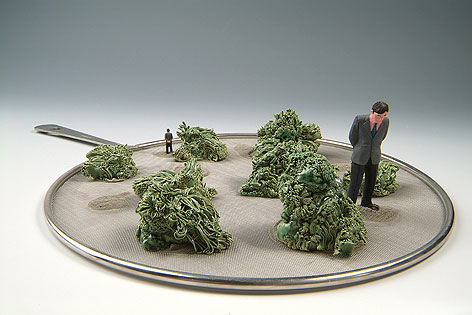Richard Slee, artist and designer
Richard Slee’s work is intrinsically concerned with the domestic interior. There are references to the decorative, the ornamental and the symbolic, both from the past and our contemporary culture. His sources are eclectic and are skilfully brought together and translated through his principal medium, ceramics.
Richard Slee has established an international reputation. Exhibitions and workshops have taken place in the Americas, Europe and the Far East. His work is represented in public collections in the United Kingdom, Australia, USA, Sweden, Holland, Japan and Korea. In 2001 he was awarded the Jerwood Applied Arts Prize for Ceramics for ‘the most significant contribution to contemporary ceramics…over the past five years’ and ‘expanding the dialogue between ceramic tradition and visual culture in ways that resonate outward’.
In 2009 on the occasion of the 150th anniversary of Brighton College of Art, Richard Slee wrote:
“I moved house and studio from London to Brighton in 1980 and shortly after was invited by David Vaughan, course director of the Wood, Metal, Ceramics and Plastics (WMCP) BA (Hons) to teach as a visiting lecturer. I worked with Sean Hetterly, the ceramic course leader, and we soon became friends. I greatly admired him, finding him too modest of his talents both as artist and lecturer. Within the department he was celebrated for organising the ceramic christmas parties, where his sense of fun was expressed through amazingly skilled huge scale cartoons that decorated the studios, satirising and ridiculing both colleagues and himself.
“Through my teaching there I met many visiting and part-time lecturers, among them ceramic artists Martin Smith and Scott Chamberlain, the sculptor Ed Allington and metal artist Amanda Bright, all of whom were to go on to develop high profile careers. We all learnt from each other.
“How did teaching on such a course affect me? I came in as specialist ceramicist and learnt from the others. The knowledge gained both in materials and design theory is still serving me well today. Recently in the crafts the buzz word has been ‘hybridity’: a cross fertilisation of disciplines and materials. In WMCP, the aims were never that of a soft ‘mixed media’ type, although with the unique mix of specialisations and the way students learned, it could be seen as a forerunner to this development in the applied arts.
“I eventually ceased teaching at Brighton to concentrate on my teaching at Camberwell College of Arts in 1990, although my Brighton connection continues through having my studio there.”
Richard Slee, 2009
